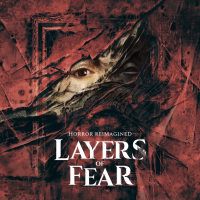Layers of Fear 2023: Act Endings
On this page you will learn all the details related to the various endings for each act of the game. You will also learn what steps to take to bring about specific epilogues.
Layers of Fear (2023) is a game with a very distinct narrative character. To further emphasize it, the creators implemented several possible endings of the stories in each act. The endings you receive to the individual stories depend on the decisions made in the course of them. This list shows every possible ending to each of the Acts of the game. We also supply useful tips and break down all decisions to help you achieve the desired ending.
For obvious reasons, this page spoils endings and plot twists from Layers of Fear (2023). If you want to find out the plot on your own, don't read any further!
- Painter's Story: Good Ending (Family)
- Painter's Story: Bad Ending (Art)
- Painter's Story: Neutral Ending (Loop)
- Daughter's Story: Good Ending (Forgiveness)
- Daughter's Story: Bad Ending (Resentment)
- Daughter's Story: True Ending (Truth)
- Musician's Story: Good ending (Acceptance)
- Musician's Story: Bad Ending (Loneliness)
- Actor's Story: The Flame Ending
- Actor's Story: Always Ending
- Actor's Story: Formless Ending
Painter's Story: Good Ending (Family)
In this ending, the main protagonist rejects the selfish and destructive motives that have drawn him towards painting. Instead, he decides to focus his attention on his fate-stricken wife and daughter, ultimately putting family above private desires. This is the most positive ending and is symbolized by a portrait of the wife and daughter.
During Painter's Story, the game secretly from the player counts the values of certain completed or uncompleted actions. The cumulative result obtained at the end determines which ending will be presented to you. Below you can learn more about decisions that count towards the Family ending.
Decisions
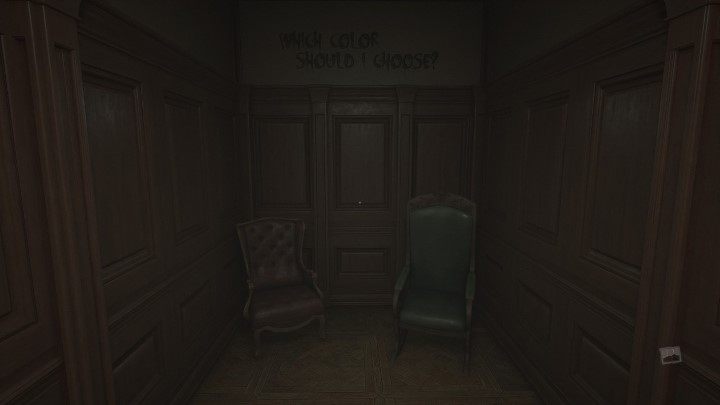


Over the course of six chapters, every now and then, you will be faced with the opportunity to make one of several choices that will affect your ending. To receive a good ending, do the following:
- Chapter 1: Choose the corridor and the picture on the side of the green armchair.
- Chapter 1: In the looping rooms, solve the mystery using the bottle of perfume.
- Chapter 2: In the looping corridor, head towards the exit marked with green color.
- Chapter 4: In the branching corridor, choose the path marked with a green house.
- Chapter 5: After the sequence in the elevator, in the room with the targets, break the chains of the echo on the right side (dollhouse, toy, violin)
- Chapter 6: After pulling the chain with the paintings, break the chain and let the images fall into the abyss.
- Chapter 6: In the corridor with the wheelchair, push the wheelchair to the end of the room.
A helpful tip - ever-present colors will help you in making the choices. Choices leading towards Family ending are often marked with green (the eye colour of the painter's wife).
Collectibles
The received ending is also affected by choices related to collectibles. The ones that you decide to interact with also count towards an overall score that detemines the received ending.

To direct fate towards a positive outcome, search for and pick up the following:
- Pages from the wife's diary (marked with a green accent).
- Drawings and toys belonging to the daughter.
- Wife's beauty products
- Instruments and objects related to music.
- Family photos.
Additionally
Apart from the elements mentioned above, the act's outcome will also be influenced by several minor aspects.

- In sequences with the phantom, the pursuing ghost may occasionally fall on her knees and start crying. Approach her when she is in such a state - this will send you back to the rebirth room but will allow you to gain some points towards the good ending.
- Throughout the chapters, some paintings will occasionally transform into a painting of the Rat Queen. If you are aiming for the "Family" ending, avoid eye contact with these pictures.
Painter's Story: Bad Ending (Art)
In the negative ending called "Art", the protagonist fully succumbs to the depths of madness, abandoning his burdened family and giving in to his worst instincts. This is the most negative of all endings, which is reflected in the egocentric self-portrait prepared by the possessed painter.
To get this ending, do the following:
Decisions


Here are key decisions and to get the bad ending, do it like this:
- Chapter 1: Choose the corridor and the picture on the side of the red armchair.
- Chapter 1: In the looping rooms, solve the mystery using a bottle of alcohol.
- Chapter 2: In the looping corridor, head towards the exit marked with a red color.
- Chapter 4: In the branching corridor, choose the path marked with red paint.
- Chapter 5: After the sequence in the elevator, in the room with the cells, break the echoes from the chains on the left side (alcohol, painting tools, picture).
- Chapter 6: After pulling the chain with the pictures, leave it undisturbed.
- Chapter 6: Ignore the wheelchair.
Similarly to the Family ending, there are certain colors that match with the choices influencing the bad ending. Choices related to the selfish, self-destructive lifestyle of a painter will often be emphasized by bloody red.
Collectibles
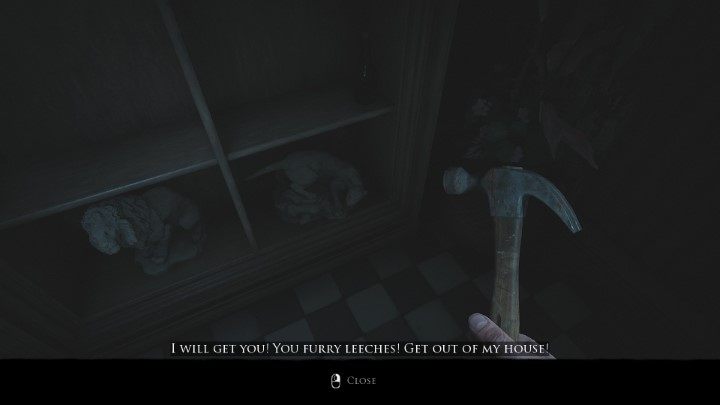
Collecting finds related to the hero's unhealthy obsession will also help you achieve the bad ending. Especially look for and pick up following items:
- Painting tools.
- Crazy drawings of rats and mousetraps.
- Alcohol.
- Weapons and sharp tools.
- Notes marked with red accents.
Additionally
- Maintain eye contact with the Rat Queen whenever she appears in the images.
Painter's Story: Neutral Ending (Loop)
In this ending, the protagonist makes a real effort to rebuild his deteriorating relationship and family ties. The destruction, however, is so great that returning to the previous, joyful state of affairs is impossible. The symbol of this ambivalent ending is the portrait of the wife, which the painter creates at the very end of the story.

This ending will be received when your actions do not significantly tip the balance toward a positive or negative outcome.
The neutral ending is probably the one that most players will see during their first playthrough. If the ending does not satisfy you, remember the possibility of replaying specific chapters (an option available from the main menu).
Knowing all variables affecting the ending will certainly help you in attaining a different, more vivid finale.
Daughter's Story: Good Ending (Forgiveness)
In this ending, with the conclusion of a sentimental journey back in time, the painter's daughter forgives her father for all the harm he had done her in her childhood. In a symbolic act, the female protagonist takes a portrait of her with her, and then sets the estate on fire as a sign of the final break with a difficult past. This is the most positive of all endings to Daugther's Story, suggesting a new beginning for the artist family.
Decisions


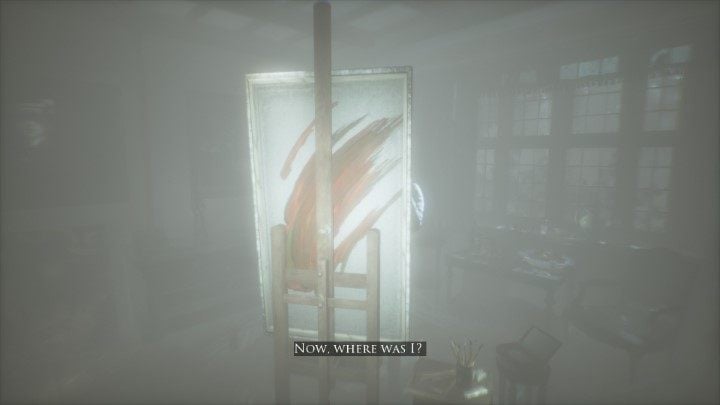
To get this ending, you need to do the following in the retrospective sections:
- Kitchen: initiate a short sequence of memories.
- Basement: before approaching the father at the piano, pick up the sheets with music on the left.
- Workshop: Start painting and place the colors on the canvas in the following order: red, black, yellow.
- Pantry: Lock the door before the angry painter approaches them.
- Upper floor: Interact with the dog before the painter approaches it.
- Office: At the junction, head towards the painter's portrait (right corridor); after placing the mother's portrait, interact with the painting; in the sequence with colorful keys, play the sequence in flawless order.
- Nursery: Maintain eye contact with the father and the canvas throughout the entire sequence.
- Musician's room: Turn on the gramophone to ease the suffering of the mother.
Daughter's Story: Bad Ending (Resentment)
The ending assumes that even after many years, the daughter still holds a grudge against her domineering father. In this sequence, the woman angrily destroys the portrait created by the painter.
The ending also suggests that the daughter died in the estate fire.
Decisions


To get the bad ending, make the following choices:
- Kitchen: Do not enter this room and do not initiate the retrospection.
- Basement: Go to the father right away.
- Workshop: Use crayons instead of brush.
- Pantry: Wait for the angry painter to approach
- Upper floor: Do not interact with the dog.
- Office: Head towards the portrait of the mother (path on the left); after placing the mother's portrait, do not interact with it; play the melody on the piano incorrectly.
- Nursery: Look away from the father and canvas.
- Musician's room: Ignore the gramophone and let the musician suffer in silence.
Daughter's Story: True Ending (Truth)
In this ending, the daughter discovers a secret hidden by her father. It turns out there is a canvas in the secret room. The ending suggests that the daughter is following in her father's footsteps and continues his mission.
Search for drawings
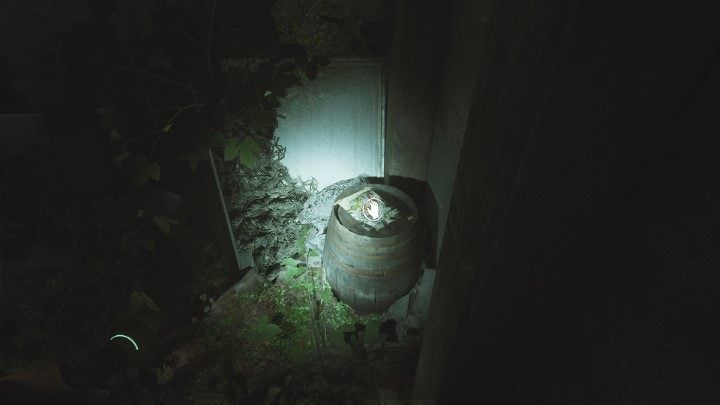
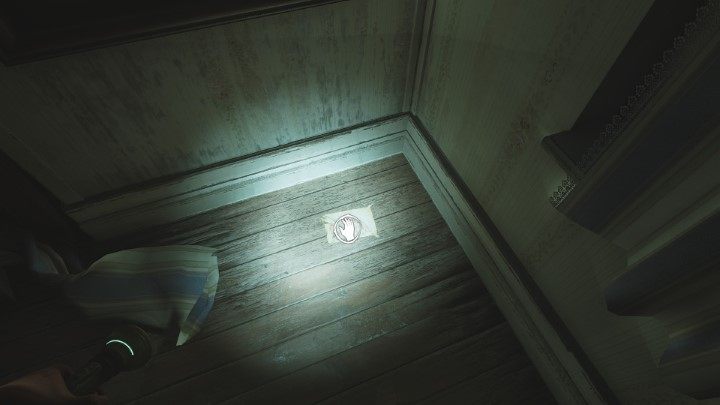

To achieve this ending, you will have to find 9 childhood drawings of the daughter. They are scattered all over the house.
- Kitchen: The drawing will appear on the wall of a small room behind the kitchen after the flashback sequence.
- Basement: The drawing will appear after the flashback sequence - you can find it on one of the boxes next to the piano.
- Workshop: Appears after the retrospective sequence, on the dresser on the left.
- Pantry: On the floor before the door, after the flashback.
- Upper floor: On the table near the mother's bedroom.
- Office: On the desk - obtainable after the retrospection.
- Nursery: On the floor near the wall - obtainable after the retrospection.
- Musician's room: in the wardrobe right from the entrance.
- The room filled with paintings (next to the nursery): in the corner of the room right from the entrance.
After collecting all of the drawings, go the workshop and place them on the wall. Arrange the images in such a way that they create a face. After the sequence, examine the cabinet on the other side of the room.
The game seems to prioritize positive outcomes of certain retrospections. In the case of searching for drawings that appear after flashback sequences, follow the hints from the positive ending.
Musician's Story: Good ending (Acceptance)
The act dedicated to the painter's wife only has 2 endings. In the more positive ending, the musician accepts her mutilated body and decides to start, a new, more free, life.
The received ending is affected by 3 choices made during the course of the act.
Decisions
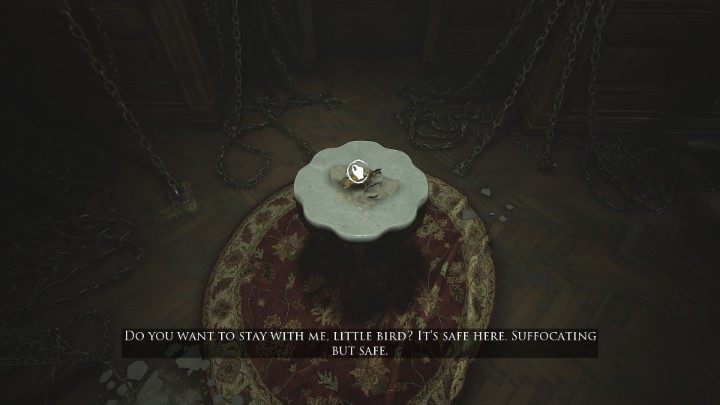
To achieve a positive outcome, make the following decisions:
- Place the body of the bird near the open window.
- In the library, choose to write on a clean sheet of paper (option on the right, marked with a violin).
- Destroy the echoes on the left side (weapon, rope, scissors)
Musician's Story: Bad Ending (Loneliness)
In this ending, the musician is unable to find herself again after the terrible accident. Not wanting to suffer any longer, the woman takes her own life.
Decisions

To bring about this conclusion, proceed in the following manner:
- Place the bird's body in the cage.
- In the library, choose to write on the damaged sheet of paper (option on the left, marked with a string).
- Destroy the echoes on the right side (toy, easel, violin).
Actor's Story: The Flame Ending
The Actor's Story, similarly to the first Act of the game, has as many as 3 possible endings. In contrast to the painter's story, however, the sequence unfolding on the ship is much less strict in terms of directing the narrative in the directions chosen by you.
Instead of a complicated system of invisible points, Actor's Story has only 4 major choices, happening in each of the act's chapters - the last chapter is without one. The ending will depend on whether the character controlled by you decides to listen to the orders of the director, or chooses the path of a rebel, opposing the commands of the oppressive artist.
In the first ending, titled "Flame", the actor decides to submit to the will of the movie director. The epilogue shows James as a person struggling with a difficult and painful past. And although it may seem that at the end of the story he manages to close a certain chapter of his life, James remains an empty shell of a man, devoid of his own subjectivity.
Decisions


In order to get "Flame" ending, follow the instructions of the director:
- Chapter 1: Shoot the female mannequin (doll on the right).
- Chapter 2: Fight with the dog over the piece of meat.
- Chapter 3: Shoot the pirate-dolls standing next to you.
- Chapter 4: Let the sea current sweep you away in the flooded corridor.
Actor's Story: Always Ending
In the "Always" ending, we assume the perspective of a woman starring in a theatrical performance and reflecting on her complicated past.
The game does not clearly imply who this heroine is. Perhaps it is Lily - James' rebellious sister, who was actually the central character of the whole story. There is also a possibility that the woman is only playing the role of an actress, and the whole story up to this point has been merely a theatrical fiction.
As for how to interpret the ending, you will have to decide for yourselves.
Decisions
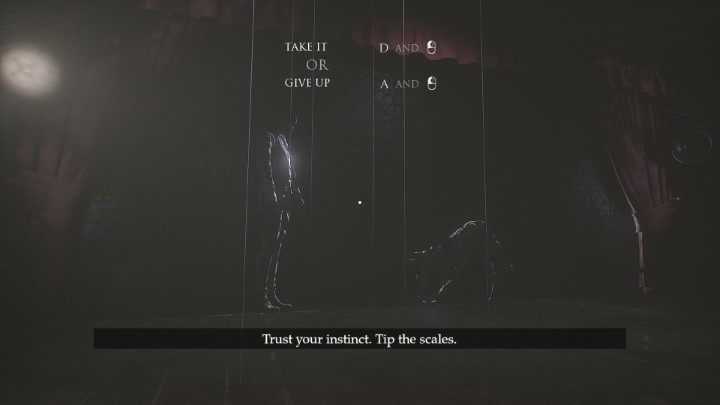

In order to achieve this ending, you must oppose the director's will at every opportunity:
- Chapter 1: Shoot the male mannequin (doll on the left).
- Chapter 2: Don't fight the dog.
- Chapter 3: Shoot the sister standing on the plank.
- Chapter 4: Resist the sea current and head towards the flame.
Actor's Story: Formless Ending
Probably the most negative ending to the Actor's story. It shows the protagonist kneeling in a cold, dark, basement. In the room, there is also the Rat Queen condemning the hero for his indecisiveness and loneliness.
Decisions
To bring about the "Formless" ending, all you have to do is to demonstrate a lack of consistency in your choices. In some occasions, submit to the director's will, in others, resist it.
You are not permitted to copy any image, text or info from this page. This site is not associated with and/or endorsed by the developers and the publishers. All logos and images are copyrighted by their respective owners.
Copyright © 2000 - 2026 Webedia Polska SA for gamepressure.com, unofficial game guides, walkthroughs, secrets, game tips, maps & strategies for top games.
